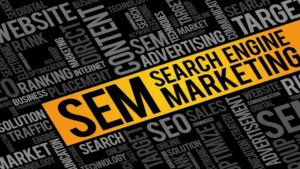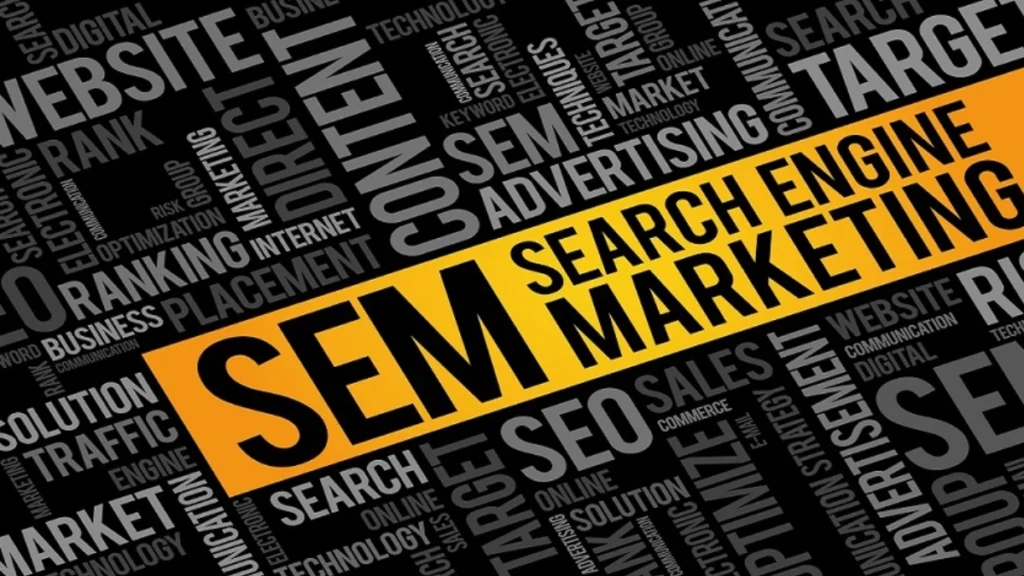SEM Marketing: Search Engine Marketing (SEM) is a powerful digital marketing strategy that helps businesses achieve immediate visibility and drive targeted traffic through paid search advertising. With the increasing competition in the digital space, SEM has become an essential component for businesses to stay ahead. This article explores the fundamentals of SEM, its benefits, key components, and best practices to help you harness its full potential.

What is SEM?
Search Engine Marketing (SEM) involves promoting websites by increasing their visibility in search engine results pages (SERPs) through paid advertising. Unlike SEO, which focuses on organic search, SEM leverages paid search ads to reach potential customers.
SEM Marketing Tools and Links
| Tool Name | Purpose | Link |
|---|---|---|
| Google Ads | Manage and optimize search ad campaigns | Google Ads |
| SEMrush | Keyword research and competitive analysis | SEMrush |
| Ahrefs | Backlink analysis and PPC insights | Ahrefs |
| SpyFu | Competitor ad analysis | SpyFu |
| WordStream | PPC campaign management | WordStream |
| Bing Ads | Advertise on Microsoft’s search network | Bing Ads |
| Keyword Planner | Find high-performing keywords | Keyword Planner |
| Adzooma | Automate and optimize ad performance | Adzooma |
| Optmyzr | Automate and streamline SEM tasks | Optmyzr |
| Unbounce | Create landing pages for SEM campaigns | Unbounce |
Steps to Launch an Effective SEM Marketing Campaign
Key Difference: SEM vs. SEO
| Factor | SEO | SEM |
|---|---|---|
| Focus | Organic traffic | Paid traffic |
| Timeline | Long-term | Immediate results |
| Cost | Free (time investment) | Paid advertising campaigns |
How Does SEM Marketing Work?
SEM operates on a pay-per-click (PPC) model, where advertisers bid for ad placements on keywords. The higher your bid and quality score, the better your ad rank.
- Select Keywords: Target relevant search queries.
- Create Ads: Write compelling ad copy.
- Set Budgets: Allocate daily spending limits.
- Monitor Performance: Use analytics to optimize campaigns.
Key Components of SEM Marketing
1. Keywords and Match Types
- Broad Match
- Phrase Match
- Exact Match
- Negative Keywords
2. Ad Campaigns
Organize ads into ad groups based on themes.
3. Targeting Options
- Location-based targeting
- Demographic targeting
- Device targeting
4. Quality Score
Google assigns a quality score based on ad relevance, landing page experience, and expected click-through rate.
Benefits of SEM Marketing
| Benefit | Description |
|---|---|
| Immediate Visibility | Appear at the top of SERPs instantly. |
| Highly targeted traffic | Reach the right audience based on their search intent. |
| Scalability | Adjust campaigns to meet your budget and goals. |
| Performance Tracking | Real-time data for clicks, conversions, and ROI optimization. |
Popular SEM Platforms
- Google Ads: The most widely used platform, offering extensive targeting tools.
- Bing Ads: A cost-effective alternative with unique audiences.
- Amazon Ads: Ideal for e-commerce businesses.
- YouTube Ads: Great for video-based promotions.
Effective Strategies for SEM Marketing
- Keyword Research: Use tools like Google Keyword Planner to find high-performing keywords.
- Ad Copy Optimization: Write engaging headlines and include CTAs.
- Landing Page Design: Ensure pages are relevant, fast, and mobile-friendly.
- A/B testing: experiment with different ads to find the best-performing options.
Common Challenges in SEM Marketing
1. Click Fraud
Competitors or bots clicking on your ads can inflate costs. Use click fraud detection tools to mitigate this risk.
2. Budget Management
Overspending can be a concern. Set clear limits and monitor campaigns daily.
3. Constant Updates
Stay informed about changes in platforms like Google Ads to maintain effectiveness.
SEM Marketing and Key Components of SEM
- Paid Search Ads (PPC): Advertisements that appear on search engine results pages when users search for specific keywords.
- Ad Auctions and Bidding: The process by which search engines decide which ads to show and in what order, based on the bids and ad quality.
- Keywords and Match Types: The specific words and phrases that trigger ads, with different match types determining how closely a user’s search query must match the keyword.
- Ad Copy and Creative: The text and visuals used in ads to attract clicks.
- Landing Pages and Conversion Optimization: The pages users land on after clicking an ad, optimized for conversions.
Benefits of SEM
Immediate Visibility and Quick Results
SEM provides instant visibility in search results, unlike SEO, which can take months to show results. This makes it ideal for new websites or time-sensitive campaigns.
Targeted Advertising
With SEM, you can target specific demographics, locations, and search behaviors, ensuring your ads reach the most relevant audience.
Measurable ROI (Return on Investment)
SEM campaigns can be closely monitored and adjusted based on performance, providing a clear understanding of ROI and enabling data-driven decisions.
Enhanced Brand Awareness
Even if users do not click on your ads, appearing in search results increases brand exposure and reinforces brand recognition.
Key Components of SEM
Paid Search Ads (PPC)
PPC ads are the backbone of SEM. They appear above or alongside organic search results, increasing visibility and driving targeted traffic.
Ad Auctions and Bidding
Search engines use ad auctions to determine which ads to display. Advertisers bid on keywords, and the highest bidders with the best ad quality win the top spots.
Keywords and Match Types
Selecting the right keywords is crucial. Different match types (broad, phrase, exact, and negative) allow you to control which searches trigger your ads.
Ad Copy and Creative
Crafting compelling ad copy and using engaging visuals are essential for attracting clicks. Highlighting unique selling points and including calls-to-action can improve ad performance.
Landing Pages and Conversion Optimization
Ensure that landing pages are relevant to the ad and optimized for user experience. A well-designed landing page can significantly improve conversion rates.
SEM Platforms
Overview of Major SEM Platforms
- Google Ads: The most popular SEM platform, offering extensive reach and advanced targeting options.
- Bing Ads: Provides access to the Bing Network with lower competition and cost-per-click.
- Yahoo Search Ads: Another option for reaching a diverse audience, though less popular than Google and Bing.
Features and Functionalities
Each platform offers unique features, such as audience targeting, ad formats, and performance tracking tools.
Choosing the Right Platform
Consider your target audience, budget, and campaign goals when selecting an SEM platform. Testing different platforms can help determine the best fit.
Keyword Research and Selection
Importance of Keyword Research
Effective keyword research is the foundation of a successful SEM campaign. It involves identifying the terms your target audience uses when searching for your products or services.
Tools for Keyword Research
- Google Keyword Planner: A free tool that provides keyword ideas and search volume data.
- SEMrush offers comprehensive keyword analysis, competitor research, and tracking.
- Ahrefs: Provides keyword difficulty scores and competitive analysis.
Strategies for Selecting High-Performing Keywords
Focus on high-intent keywords that indicate a strong likelihood of conversion. Balance popular keywords with long-tail keywords to capture niche audiences.
Ad Creation and Optimization
Writing Effective Ad Copy
Create clear, concise, and compelling ad copy that highlights your unique selling points. Use action-oriented language to encourage clicks.
Importance of Ad Extensions
Ad extensions provide additional information and can improve ad visibility and CTR. Common extensions include site links, callouts, and structured snippets.
Best Practices for Ad Design
Ensure your ads are visually appealing and aligned with your brand. Use high-quality images and maintain consistency across your ad campaigns.
A/B Testing and Optimization
Continuously test different ad variations to identify what works best. Adjust your ad copy, visuals, and targeting based on performance data.
Bidding Strategies
Types of Bidding Strategies
- Manual CPC: You set the maximum cost-per-click for your ads.
- Automated Bidding: The platform automatically adjusts bids to achieve specific goals.
- Enhanced CPC: Combines manual bidding with automated adjustments based on conversion likelihood.
Setting bid limits and budget allocation
Allocate your budget effectively by setting daily or campaign-level limits. Monitor and adjust your bids to maximize ROI.
Adjusting Bids Based on Performance
Analyze campaign performance regularly and adjust bids to optimize for high-performing keywords and ads.
Smart Bidding Strategies
Leverage machine learning and advanced algorithms to automate bid adjustments based on real-time data and performance.
Tracking and Analytics
Importance of Tracking SEM Performance
Tracking performance is crucial for understanding the effectiveness of your SEM campaigns and making data-driven decisions.
Tools for Tracking and Analytics
- Google Analytics provides detailed insights into user behavior and campaign performance.
- SEMrush offers comprehensive tracking and reporting features for SEM campaigns.
Key Metrics to Monitor
- Click-Through Rate (CTR): Measures the percentage of users who click on your ads.
- Conversion Rate: The percentage of users who complete a desired action after clicking your ad.
- Cost Per Click (CPC): The amount you pay for each click on your ads.
Using Data to Optimize SEM Campaigns
Regularly review performance data to identify trends, optimize keywords, adjust bids, and improve ad copy.
Best Practices for SEM
Creating a Structured SEM Plan
Develop a clear plan outlining your goals, target audience, budget, and key strategies for your SEM campaigns.
Ongoing Keyword Optimization
Regularly update your keyword list to reflect changing search trends and optimize for high-performing keywords.
Regularly updating and testing ad copy
Keep your ad copy fresh and relevant by regularly testing new variations and updating content.
Monitoring and Adjusting Bids
Continuously monitor bid performance and make adjustments to maximize ROI and achieve your campaign goals.
Ensuring Landing Page Relevance and Quality
Optimize landing pages to ensure they are relevant to the ad and provide a seamless user experience.
Challenges and Solutions in SEM
Common Challenges in SEM
- High Competition: Competing with other advertisers for top positions.
- Click Fraud: Unintentional or malicious clicks that waste budget.
- Budget Constraints: Managing limited budgets effectively.
Strategies for Overcoming Challenges
- Refine Targeting: Use precise targeting to reach the right audience.
- Monitor Click Fraud: Use tools and strategies to detect and prevent click fraud.
- Optimize Budget: Allocate budget to high-performing campaigns and keywords.
Case Studies of Successful SEM Campaigns
Highlight examples of businesses that have successfully implemented SEM strategies to achieve their marketing goals.
Future Trends in SEM
Emerging Trends
- AI and Machine Learning: Automating and optimizing SEM campaigns with advanced algorithms.
- Voice Search: Adapting SEM strategies for voice-activated search queries.
- Visual Search: Leveraging visual content and image-based searches in SEM.
Predictions for the Future of SEM
Expect continued advancements in AI and automation, increasing importance of voice and visual search, and more personalized ad experiences.
Staying Ahead in the Evolving SEM Landscape
Stay updated with industry trends, continuously test and optimize your campaigns, and embrace new technologies to maintain a competitive edge.
Conclusion
Search Engine Marketing (SEM) is a powerful tool for achieving immediate visibility and driving targeted traffic to your website. By understanding its key components, benefits, and best practices, you can effectively leverage SEM to achieve your digital marketing goals. Implement these strategies to enhance your online presence, improve ROI, and stay ahead in the competitive digital landscape.

